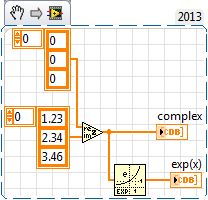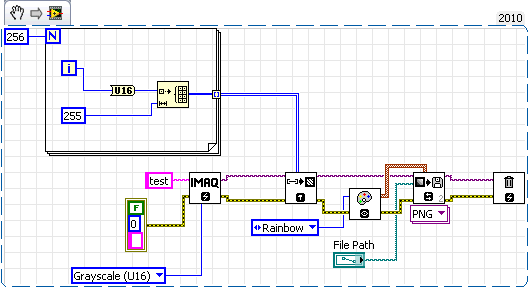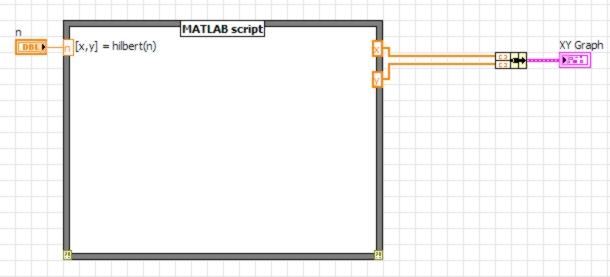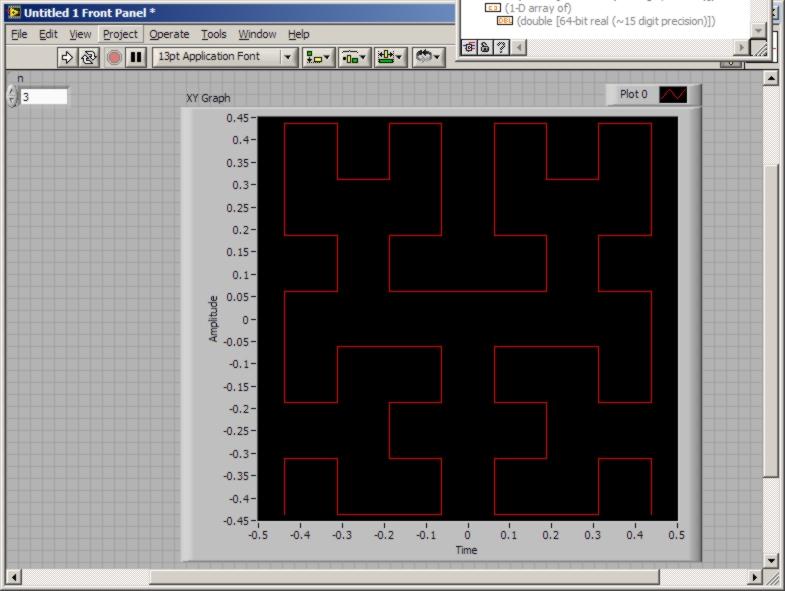-
Posts
13 -
Joined
-
Last visited
Content Type
Profiles
Forums
Downloads
Gallery
Posts posted by Biometrology
-
-
-
Thanks asbo,
 I don't know why I couldn't fond that information...The problem lies in the fact that these predefined palettes for IMAQ are all 256 element array palettes. A signed 16-bit image (I16) has 65,536 possible values so these will not work with the IMAQ predefined palettes.Kind of of obvious really, if there aren't enough values in the colour map it won't work. But it's a bit disappointing that this all happens silently without any helpful error messages...I'll try converting to U8 as the images for presentation rather than analysis.A.
I don't know why I couldn't fond that information...The problem lies in the fact that these predefined palettes for IMAQ are all 256 element array palettes. A signed 16-bit image (I16) has 65,536 possible values so these will not work with the IMAQ predefined palettes.Kind of of obvious really, if there aren't enough values in the colour map it won't work. But it's a bit disappointing that this all happens silently without any helpful error messages...I'll try converting to U8 as the images for presentation rather than analysis.A. -
-
I'm afraid I can't help with the server setup - fortunately our IT department took care of that for me
 .
.The shell extension generally works very well and there's really no big need for the LV integration. The other advantage of working this way is that you can use TortoiseSVN with other programming languages you may use (if that's not sacrilege!)
 - for example I use it a lot for MATLAB code and also for LaTeX. it can all go in the same repository without any worries.
- for example I use it a lot for MATLAB code and also for LaTeX. it can all go in the same repository without any worries.I'd not used source control before, but I was an instant convert. You'll never look back!
Cheers
Alex
-
We're a relatively small development group. There will probably be at most 3 people (but usually just me) accessing the code. Do you know if it's necessary to have a special server or could we just have the repository on a network drive? If we do set it up that way at first would it be hard to migrate to a server later if necessary?
George, you could do this (I did) - but I wouldn't necessarily recommend it.
One of the problems of keeping the repository on a network drive is that any random person can accidentally move, delete or rename the path to them.

To move from the shared drive to a server I had to do the following steps (from memory):
 export the repository using Subversion (I had to install it just to do this).
export the repository using Subversion (I had to install it just to do this). The very large file resulting then had to be imported into the new repository on the server by one of our IT guys
The very large file resulting then had to be imported into the new repository on the server by one of our IT guys All the working copies then have to be changed to point at the new repositories (using the relocate command)
All the working copies then have to be changed to point at the new repositories (using the relocate command) This only works if the repository has not changed since you exported it!!!!
This only works if the repository has not changed since you exported it!!!!Hope this guides your decision....

Alex
-
Hi
i am working in a project using basically labview 8.2 and i wrote a program in matlab R2008(m file)and i want to run this file in my labview program; i also load this program into mathscript window but it didn't work because the m file contains many functions; i was wondering if you can please help me in this manner.
looking forward to recieving from you
You need to use a MATLAB script node. This requires you to have a MATLAB licence available but enables you to run native MATLAB code including using the toolboxes.
You just need to have a script file that calls your functions - like in the example here.
Cheers
Alex
-
Thanks, Gary. I'll check it out when I get back from travel.
And my apologies to GSR for kinda hijacking this thread.
There's also the Math Interface Toolkit, which lets you call Labview from MATLAB. Not sure how that would work in a compiled application though.
I briefly looked into the possibility of calling a MATLAB-generated DLL from LabVIEW. Turns out not to be so easy (Translation: I gave up).
Mathscript might be the way forward, if your code doesn't need any of the MATLAB toolboxes.
Cheers
Alex
-
This is really interesting. As some of you may know, I'm having memory issues with LabVIEW and data analysis/display. Any comments on how efficiently MATLAB handles memory - specifically when working with large data sets? Does anyone else out there think MATLAB is better for this than LabVIEW?
Cat
I didn't say that MATLAB was better than LabVIEW at memory management! - In fact often the reverse...
Actually, it depends on what you are trying to do. One of the problems in MATLAB is importing integer data without it being converted into double.
But once you have the data in MATLAB, there are a number of things you can do to manage memory efficiently. You might want to take a look at this webinar: http://www.mathworks...=32517&p2=32518.
Cheers
Alex
-
What do you think about them?
I think (My information may not be right, just for discussion)
LabVIEW
- Easy to use to communicate to hardwares, especially NI hardware
- Relative easy to interact with other programming language (talk to Matlab, etc)
- Graphical control is unknown. I am not sure how to use LabVIEW to do some graphic control, like draw a sun and a house. Can we do that??
Matlab/Simulink- Easy to use to communicate to many different company hardware IF the cards are support (I have an NI card which is not support by Matlab)
- Not sure how to interact with other language. I did use it to interact with Java2D which was OK. However, Simulink only allow to use C++ to do real-time graphic which needed to do many setting to communicate in between each others (I still don't know how to do that)
GSR, I can't comment on all your points, but I can make a few remarks based on personal experience:
You can interface MATLAB with a lot of hardware, but in my experience this can be done more easily, with more hardware, in LabVIEW. We had an NI counter/timer card which was listed as supported by the MathWorks data acquisition toolbox. So we bought the toolbox, only to discover that only the digital I/O functions of the card were supported but not the counter/timer functions (because there are no counter/timer functions in the toolbox). The only reason for using the data acquisition toolbox is if you are a primarily MATLAB user who doesn't want to buy LabVIEW and needs to import data directly to the MATLAB workspace. Despite having a significant MATLAB code base, we bought LabVIEW.
Picture controls allow you draw objects in the LabVIEW front panel. Is this what you meant?
There are a variety of ways of interfacing MATLAB with other programming languages/code, e.g. Java, C, C++, I think FORTRAN and DLLs. You can also use ActiveX.
For data acquisition, I would almost always go for LabVIEW, because of the easier hardware interfacing, more sophisticated GUI design, better multi-threading/timing control and memory management.
For data analysis, I would tend to go for MATLAB in most cases, because of the ease of doing exploratory data analysis, which can then be captured into code, and the better graphics and extensive libraries. Having said that, I recently wrote a data analysis GUI in LabVIEW because I can run this without being connected to my company's network (license server needed for MATLAB and toolboxes).
I'm still wrestling with the various ways of communicating or data transfer between the two environments...
Cheers
Alex (Biometrology)
-
QUOTE (OlivierL @ Nov 5 2008, 05:39 PM)
I agree with you guys that is would be a really nice feature to have for multiple dimension. Also, I like the idea of the permute function and it should exist in LV. In the mean time, I can share this VI I wrote some time ago to "Transpose" a 3D array. Its input is a 3D array of double and you specify which dimension remains unchanged.Olivier
Very neat Olivier - thanks! :thumbup:
Alex
-
This is a great idea - I have been having exactly this problem recently, working with 3D arrays.
An alternative would be a more powerful transposition function, something like the permute function in MATLAB, where you can freely re-order the dimensions of an N-D array. Then you could simply re-order the dimensions before/after the for-loop.
And while we're at it, how about something like the MATLAB squeeze command, which removes "singleton" dimensions, i.e. dimensions with size 1?
Alex







Sum to values from a .csv and save it to a new .csv file
in Database and File IO
Posted
As hooovahh said, you need to use a for loop to index into the array. Inside the for loop you will have a 1D array which you need to index the first and second elements and add them. Concatenate that with the input 1 D array.
Auto-indexing is your friend here.